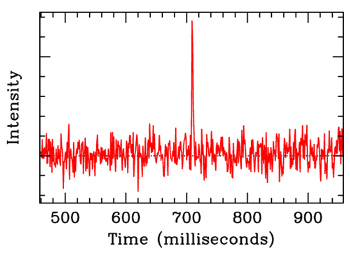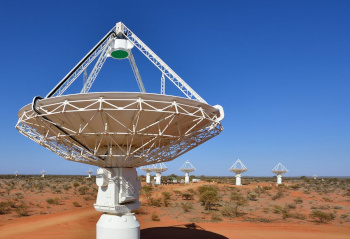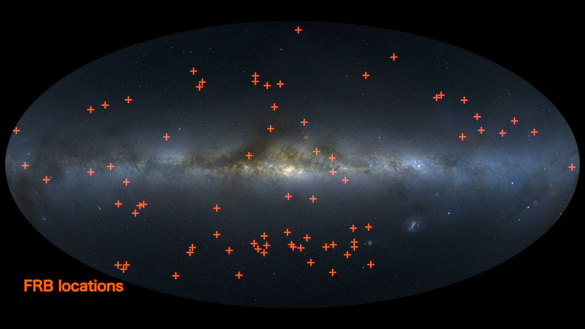Fast Radio Bursts
December 11, 2023
The
measurement of
physical properties to greater
accuracy is an important part of
physics.
Deviation of measured values of physical properties from
expected results demonstrates that a particular
model is in
error; and, there might be some new physics
lurking in the shadows. Often the deviation is very small; so, there's always an
impetus to improve measurement
precision. I wrote about a current example of this in a
recent article (Fifth Force,October 2, 2023), the
Muon g-2 Experiment at the
Fermi National Accelerator Laboratory (Fermilab).[1] This
experiment found a significant deviation of the
gyromagnetic ratio of the
muon at the 12th
decimal place.[1]

James Clerk Maxwell (1831-1879) is best known for his electrodynamic equations. He also deduced a set of thermodynamic equations, known as his relations to avoid confusion, as shown here. (Left image, an engraving of Maxwell by George J. Stodart from Wikimedia Commons. The equations were rendered using Inkscape. Click for larger image.)
Preeminent
Scottish physicist,
James Clerk Maxwell (1831-1879),
published an 1860 paper on the
kinetic theory of gases, entitled "Illustrations of the dynamical theory of gases," in which he
calculates from
first principles the
properties on an
ideal gas.[2] In this paper, Maxwell remarks that his result for the
specific heat of
diatomic gases at low
temperature differed from the measured values. The root of this problem was a
quantum mechanical effect not understood until fifty years later, and it underscores the importance of measurement in physics. As Maxwell wrote in his paper,
"In order to lay the foundation of such investigations on strict mechanical principles, I shall demonstrate the laws of motion of an indefinite number of small, hard, and perfectly elastic spheres acting on one another only during impact."[2]
and,
"This mathematical result appears to be in conflict with known experimental values for the specific heats of gases."[2]
Until recently,
astronomical observations were something done during the few hours of
darkness available at
night. In the really early days of
astrophotography, when
chemical imaging was all that was available, some images were created over the course of many nights by storing the
photographic plate in darkness during the day between multiple
exposures. The emergence of
radio astronomy in the
mid-20th century allowed observation of regions of
space whenever they were over the
horizon, day or night.
The earliest realization that some astronomical
phenomena happened on very short time scales was the discovery of
pulsars in 1967 by
Jocelyn Bell (b. 1943), with the
discovery's being
credited to her
thesis advisor,
Antony Hewish (1924-2021).[3] The first observed pulsar,
PSR B1919+21, has a
period of 1.3373 seconds, and a
pulse width of just 40
milliseconds.[3]
Fast radio bursts (FRBs) are another
transient astronomical
radio wave with pulse width as low as a fraction of a millisecond. It's
estimated that a typical FRB releases as much
energy in a millisecond as the energy output of our
Sun over several days. The first FRB was discovered in 2007 in a search through
archival pulsar
survey data. Fewer than a thousand FRBs have been
detected to date, and the locations of just 5% of these has been determined, although it's estimated that there are as many as 10,000 unobserved fast radio bursts per day.[4]

The data record of fast radio burst FRB 140514 detected at Parkes Observatory, New South Wales, Australia, on May, 14, 2014.
(Swinburne Astronomy Productions image, via Niels Bohr Institute.)
A recently discovered FRB demonstrates the
ubiquity of these events in the
universe. In 2022, the
Australian Square Kilometre Array Pathfinder radio telescope in
Western Australia had detected a radio burst from a source more than halfway back to the
Big Bang. This FRB, designated FRB 20220610A, was traced back to a
morphologically unusual group of
galaxies at
redshift 1.016 ± 0.002.[6-9]
The discovery was by a huge
international research team from
Macquarie University (Sydney, Australia), the
Australia Telescope National Facility (Epping, Australia), the
Netherlands Institute for Radio Astronomy (Dwingeloo, Netherlands),
Swinburne University of Technology (Hawthorn, Australia),
Curtin University (Perth, Australia),
Northwestern University (Evanston, Illinois), the
University of California (Berkeley, California), the
University of California (Santa Cruz, California), the
Kavli Institute for the Physics and Mathematics of the Universe (Kashiwa, Japan), the
Square Kilometre Array Observatory (Jodrell Bank, United Kingdom), the
University of Sydney (Sydney, Australia), and the
Pontificia Universidad Católica de Valparaíso (Casilla, Chile)

The Australian Square Kilometre Array Pathfinder.
This radio telescope is located at the Murchison Radio-astronomy Observatory in Western Australia, which is in the Australian Radio Quiet Zone WA (ARQZWA), established to isolate the radio astronomy receivers from potential interference.[10] (CSIRO image.)
The location of FRB 20220610A was (
standard equinox J2000)
right ascension, 23h 24m 17.569s ± 0.040s, and
declination, -33° 300' 49.3700'' ± 0.5000. The radio burst was detected at 1271.5
MHz, and the detector
time resolution of 1.18 ms indicated a pulse shorter than that.[6] The pulse energy was (6.4 ± 0.7) x 10
32 erg/
hertz, for a total burst energy of about 2x10
42 erg, which is three-and-a-half times as energetic as all unambiguously localized FRBs.[6,9] This energy is equivalent to the total emission of the Sun over the course of 30 years.[8]
The Australian Square Kilometre Array Pathfinder was able to give an accurate location for FRB 20220610A, and this allowed the
European Southern Observatory's Very Large Telescope in
Chile to pinpoint the source.[8] This was a
peculiar galaxy that looked as if it was
merging with one or two other galaxies.[7] It was determined that the
probability of correct association was greater than 99.99%.[6] This galaxy is eight billion
light years distant.[8] The previous FRB record distance is 5 billion light years.[9]
Fast radio bursts have a potential application in the measurement of the
density of
matter of the universe. That's because
charged particles such as
electrons in the path from source to the
Earth cause
dispersion, so it's possible to determine the matter density along the path.[6,9] This would give insight into the fact that more than half of normal matter is
missing, possibly contained within thin
filaments connecting galaxies.[7-8] While the origin of fast radio bursts is presently unknown, most astronomers think that they are
magnetars, highly
magnetic neutron stars.[7] This research was
funded by the
U.S. National Science Foundation, the
Australian Research Council, the
Nederlandse Organisatie voor Wetenschappelijk Onderzoek (Dutch Research Council), and the Fondo Nacional de Desarrollo Científico y Tecnológico.[6]

Locations of some fast radio bursts. (screenshot of a NASA Science Visualization Studio animation.[11] Click for larger image.)
References:
- D. P. Aguillard, et al., "Measurement of the Positive Muon Anomalous Magnetic Moment to 0.20 ppm," preprint submitted for publication in Physical Review Letters at the g-2 website at Fermilab.
- J.C. Maxwell, "Illustrations of the dynamical theory of gases, Part I, On the motions and collisions of perfectly elastic spheres," The London, Edinburgh, and Dublin Philosophical Magazine and Journal of Science, 4th Series, vol.19, pp.19-32 (PDF File, via Universitat de Barcelona).
- A. Hewish, S. J. Bell, J. D. H. Pilkington, P. F. Scott, and R. A. Collins, "Observation of a Rapidly Pulsating Radio Source, Nature, vol. 217 (February 24, 1968), pp. 709-713, https://doi.org/10.1038/217709a0.
- Radio-burst discovery deepens astrophysics mystery, Max Planck Institute Press Release, July 10, 2014.
- Snapshot of cosmic burst of radio waves, Niels Bohr Institute Press Release, January 19, 2015.
- S. D. Ryder, K. W. Bannister, S. Bhandari, A. T. Deller, R. D. Ekers, M. Glowacki, A. C. Gordon, K. Gourdji, C. W. James, C. D. Kilpatrick, W. Lu, L. Marnoch, V. A. Moss, J. X. Prochaska, H. Qiu, E. M. Sadler, S. Simha, M. W. Sammons, D. R. Scott, N. Tejos, and R. M. Shannon, "A luminous fast radio burst that probes the Universe at redshift 1," Science, vol. 382, no. 6668 (October 19, 2023), pp. 294-299, DOI: 10.1126/science.adf2678. Also at arXiv.
- Daniel Lawler, "'Mind-blowing': Astronomers spot most distant radio burst yet," Phys.org, October 22, 2023/
- Nina Massey, "Astronomers detect most distant fast radio burst to date," The Independent (UK), October 19, 2023.
- Chen Ly, "A blast of radio waves hit Earth after travelling for 8 billion years," New Scientist, October 19, 2023.
- ASKAP Radio Telescope Web Site.
- Hubble Tracks Origins Of Energy Blasts, NASA Science Visualization Studio, May 3, 2023.
Linked Keywords: Measurement; physical properties; accuracy; physics; deviation (statistics); scientific theory; expected result; conceptual model; error; hidden; lurking in the shadows; impetus; precision; Muon g-2 Experiment; Fermi National Accelerator Laboratory (Fermilab); experiment; gyromagnetic ratio; muon; significant figures; decimal place; James Clerk Maxwell (1831-1879); Maxwell's equations; Maxwell's electrodynamic equations; deductive reasoning; deduce; thermodynamic; equations; Maxwell relations; confusion; Wikimedia Commons; Inkscape; Scotland; Scottish; physicist; scientific literature; publish; kinetic theory of gases; calculation; calculate; first principles; physical property; ideal gas; specific heat; diatomic molecule; diatomic gas; temperature; Maxwell-Boltzmann distribution; quantum mechanical effect; classical mechanics; mechanical principle; Newton's laws of motion; hardness; hard; elasticity (physics); elastic; sphere; impact (mechanics); mathematics; mathematical; observational astronomy; astronomical observation; darkness; night; astrophotography; photographic film; chemical imaging; photographic plate (astronomy); exposure (photography); radio astronomy; mid-20th century; outer space; horizon; phenomenon; phenomena; pulsar; Jocelyn Bell (b. 1943); discovery (observation); scientific priority; credit; doctoral advisor; thesis advisor; Antony Hewish (1924-2021); PSR B1919+21; frequency; period; pulse (signal processing); pulse width; millisecond; fast radio burst (FRB); time-domain astronomy; transient; radio wave; approximation; estimate; energy; Sun; archive; archival; astronomical survey; data; detector (radio); detected; chart recorder; record; FRB 140514; Parkes Observatory; New South Wales; Australia; Niels Bohr Institute; ubiquity; universe; Australian Square Kilometre Array Pathfinder; Western Australia; Big Bang; galaxy morphological classification; morphologically unusual; galaxy; galaxies; redshift; international; research; Macquarie University (Sydney, Australia); Australia Telescope National Facility (Epping, Australia); ASTRON; Netherlands Institute for Radio Astronomy (Dwingeloo, Netherlands); Swinburne University of Technology (Hawthorn, Australia); Curtin University (Perth, Australia); Northwestern University (Evanston, Illinois); University of California (Berkeley, California); University of California (Santa Cruz, California); Kavli Institute for the Physics and Mathematics of the Universe (Kashiwa, Japan); Square Kilometre Array Observatory (Jodrell Bank, United Kingdom); University of Sydney (Sydney, Australia); Pontificia Universidad Católica de Valparaíso (Casilla, Chile); Australian Square Kilometre Array Pathfinder; Murchison Radio-astronomy Observatory; Western Australia; Australian Radio Quiet Zone WA (ARQZWA); receiver (radio); electromagnetic interference; CSIRO image; standard equinox J2000; right ascension; declination; MHz; temporal resolution; time resolution; erg; hertz; European Southern Observatory; Very Large Telescope; Chile; galaxy morphological classification; peculiar; galaxy merger; probability; light year; density; matter; charge (physics); charged; elementary particle; electron; Earth; dispersion (optics); galaxy filament; magnetar; magnetic field; neutron star; funding of science; funded; U.S. National Science Foundation; Australian Research Council; Nederlandse Organisatie voor Wetenschappelijk Onderzoek (Dutch Research Council); screenshot; NASA Science Visualization Studio animation.